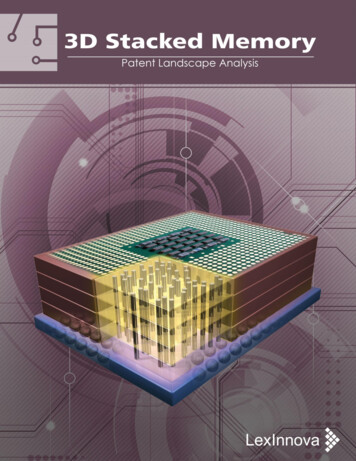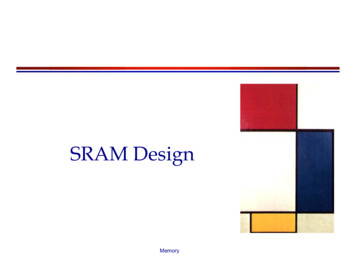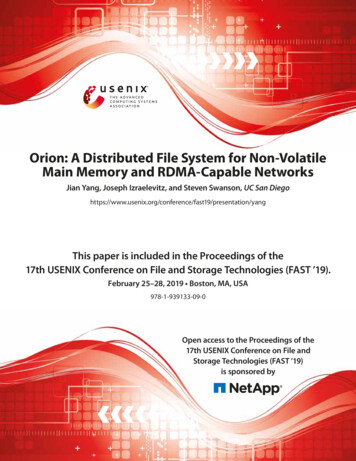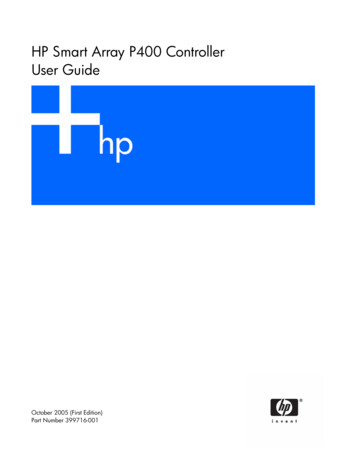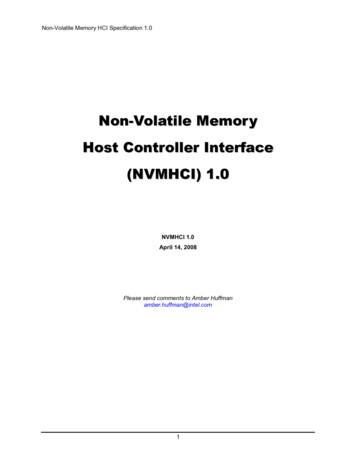
Transcription
Non-Volatile Memory HCI Specification 1.0Non-Volatile Memor yHost Controller Interface(NVMHCI) 1.0NVMHCI 1.0April 14, 2008Please send comments to Amber Huffmanamber.huffman@intel.com1
Non-Volatile Memory HCI Specification 1.0Non-Volatile Memory Host Controller Interface revision 1.0 specification available for download athttp://www.intel.com/standards/nvmhci/index.htm. Ratified on April 14, 2008.SPECIFICATION DISCLAIMERTHIS SPECIFICATION IS PROVIDED TO YOU “AS IS” WITH NO WARRANTIES WHATSOEVER,INCLUDING ANY WARRANTY OF MERCHANTABILITY, NON-INFRINGEMENT, OR FITNESS FORANY PARTICULAR PURPOSE. THE AUTHORS OF THIS SPECIFICATION DISCLAIM ALL LIABILITY,INCLUDING LIABILITY FOR INFRINGEMENT OF ANY PROPRIETARY RIGHTS, RELATING TO USEOR IMPLEMENTATION OF INFORMATION IN THIS SPECIFICATION. THE AUTHORS DO NOTWARRANT OR REPRESENT THAT SUCH USE WILL NOT INFRINGE ANY SUCH RIGHTS. THEPROVISION OF THIS SPECIFICATION TO YOU DOES NOT PROVIDE YOU WITH ANY LICENSE,EXPRESS OR IMPLIED, BY ESTOPPEL OR OTHERWISE, TO ANY INTELLECTUAL PROPERTYRIGHTS.Copyright 2007-2008, Intel Corporation. All rights reserved.All product names, trademarks, registered trademarks, and/or servicemarks may be claimed as theproperty of their respective owners.NVMHCI Workgroup Chair:Amber HuffmanIntel CorporationMS: JF2-53th2111 NE 25 AvenueHillsboro, OR 97124amber.huffman@intel.com2
Non-Volatile Memory HCI Specification 1.0Table of Contents1INTRODUCTION . 61.11.21.31.41.5Overview. 6Scope. 6Outside of Scope . 6Conventions. 6Definitions . 101.6Keywords . cation unit .7command completion .7metadata .7NVM .7NVM device.7NVM page .7NVM page aligned.7NVM subsystem .7port .7sector .7mandatory .7may .7optional.8R.8reserved .8shall.8should.8Conventions. 8Byte, word and Dword Relationships. 9References . 9PCI REGISTERS . 112.1PCI Header . 82.1.192.1.202.1.212.2PCI Power Management Capabilities. 152.2.12.2.22.2.32.3Offset 00h: ID - Identifiers .11Offset 04h: CMD - Command.12Offset 06h: STS - Device Status.12Offset 08h: RID - Revision ID .12Offset 09h: CC - Class Code.13Offset 0Ch: CLS – Cache Line Size .13Offset 0Dh: MLT – Master Latency Timer .13Offset 0Eh: HTYPE – Header Type.13Offset 0Fh: BIST – Built In Self Test (Optional).13Offset 10h: MLBAR – Memory Register Base Address, lower 32-bits.13Offset 14h: MUBAR – Memory Register Base Address, upper 32-bits.13Offset 18h: IDBAR – Index/Data Pair Register Base Address.14Offset 1Ch – 23h: BARS – Other Base Addresses (Reserved).14Offset 24h – 27h: BAR5 – Vendor Specific .14Offset 28h: CCPTR – CardBus CIS Pointer .14Offset 2Ch: SS - Sub System Identifiers .14Offset 30h: EROM – Expansion ROM (Optional) .14Offset 34h: CAP – Capabilities Pointer.14Offset 3Ch: INTR - Interrupt Information .14Offset 3Eh: MGNT – Minimum Grant .14Offset 3Fh: MLAT – Maximum Latency .15Offset PMCAP: PID - PCI Power Management Capability ID.15Offset PMCAP 2h: PC – PCI Power Management Capabilities.16Offset PMCAP 4h: PMCS – PCI Power Management Control And Status.16Message Signaled Interrupt Capability (Optional) . 162.3.1Offset MSICAP: MID – Message Signaled Interrupt Identifiers .163
Non-Volatile Memory HCI Specification 1.02.3.22.3.32.3.42.3.52.43Other Capability Pointers. 17CONTROLLER REGISTERS . 183.1Generic Host Control . 183.1.13.1.23.1.33.1.43.23.33.4Controller Memory Space Usage . 24Port Memory Usage. 244.2.14.2.2Command List Structure.24Command Table.28MEMORY ORGANIZATION AND COMMAND SET . 315.15.25.3Memory Organization . 31Command Status . 31Command Definitions . 325.3.15.3.25.3.35.3.45.3.55.3.65.3.75.3.8Dataset Management .32Flush .36Get Features .37Get Status .38Identify.43Read.47Set Features.49Write.53DATA TRANSFER OPERATION . 576.16.2Introduction . 57System Software Rules (Normative) . 576.2.16.2.26.2.36.2.47Restrictions .23Register Definition .23Offset 00h: IDX – Index Register.23Offset 04h: DAT – Data Register.23SYSTEM MEMORY STRUCTURES . 244.14.26Offset 00h: PxCLB – Port x Command List Base Address .21Offset 04h: PxCLBU – Port x Command List Base Address Upper 32-bits .21Offset 10h: PxIS – Port x Interrupt Status .21Offset 14h: PxIE – Port x Interrupt Enable .21Offset 18h: PxCMD – Port x Command and Status.22Offset 24h: PxSIG – Port x Signature.22Offset 38h: PxCI – Port x Command Issue.22Offset 70h to 7Fh: PxVS – Vendor Specific.23Index/Data Pair registers . 233.4.13.4.23.4.33.4.45Offset 00h: CAP – Controller Capabilities .19Offset 08h: IS – Interrupt Status Register.19Offset 0Ch: PI – Ports Implemented.19Offset 10h: VS – NVMHCI Version.19Generic Host Control under AHCI . 19Port Registers (one set per port) . 203.3.13.3.23.3.33.3.43.3.53.3.63.3.73.3.84Offset MSICAP 2h: MC – Message Signaled Interrupt Message Control.17Offset MSICAP 4h: MA – Message Signaled Interrupt Message Address .17Offset MSICAP 8h: MUA – Message Signaled Interrupt Upper Address (Optional).17Offset MSICAP Ch: MD – Message Signaled Interrupt Message Data .17Basic Steps when Building a Command.57Processing Completed Commands .57Data Transfer .58Software Examples (with PRD index fill out) .58ERROR REPORTING AND RECOVERY . 627.1Error Types . 627.1.1System Memory Errors.624
Non-Volatile Memory HCI Specification 1.07.1.27.1.37.2Error Recovery. 627.2.18Fatal NVM Device Errors.62Status Errors .62Host Software Error Recovery.62INFORMATIVE APPENDIX . 648.1Option ROM and EFI Information . 648.1.18.1.28.1.38.1.4EFI GUID.64Version Information .64Option ROM Discovery.64EFI Module Discovery .655
Non-Volatile Memory HCI Specification 1.011.1IntroductionOverviewThis specification defines the host software interface for the Non-Volatile Memory Host ControllerInterface (NVMHCI). NVMHCI is a register level interface that allows host software to communicate witha platform non-volatile memory subsystem.NVMHCI may either be a stand-alone PCI class device or it may be a port within an Advanced HostController Interface (AHCI) device. The specification draws heavily upon the AHCI specification.1.2ScopeNVMHCI defines a register interface for communication with a non-volatile memory subsystem. It alsodefines a standard command set for use with the NVM device.1.3Outside of ScopeNVMHCI is specified apart from any usage model for the NVM, but rather only specifies thecommunication interface to the NVM subsystem. Thus, NVMHCI does not specify whether the nonvolatile memory system is used as a main memory, a cache memory, a backup memory, a redundantmemory, etc. Specific usage models are outside the scope, optional, and not licensed.NVMHCI is also specified above any non-volatile memory management, like wear leveling. Erases andother management tasks for NVM technologies like NAND are abstracted.NVMHCI does not contain any information on caching algorithms or techniques. How the non-volatilememory is used for system level benefit is beyond the scope of this specification.The implementation or use of other published specifications referred to in this specification, even ifrequired for compliance with the specification, are outside the scope of this specification (for example,PCI, PCI Express and PCI-X).1.4ConventionsHardware shall return ‘0’ for all bits and registers that are marked as reserved, and host software shallwrite all reserved bits and registers with the value of ‘0’.Inside the register section, the following abbreviations are used:RORWR/WRWCRWSImpl SpecHwInitRead OnlyRead WriteRead Write. The value read may not be the last value written.Read/Write ‘1’ to clearRead/Write ‘1’ to setImplementation Specific – the controller has the freedom to chooseits implementation.The default state is dependent on device and system configuration.The value is initialized at reset, either by an expansion ROM, or in thecase of integrated devices, by a platform BIOS.When a register bit is referred to in the document, the convention used is “Register Symbol.Field Symbol”.For example, the configuration space PCI command register parity error response bit is referred to by thename CMD.PEE. If the register field is an array of bits, the field will be referred to as “RegisterSymbol.Field Symbol(array offset)”.When a memory field is referred to in the document, the convention used is “Register Name[OffsetSymbol]”.6
Non-Volatile Memory HCI Specification 1.01.51.5.1Definitionsallocation unitThe smallest number of NVM pages that should be allocated by host software in file or cluster allocations.1.5.2command completionA command is completed when the NVMHCI controller has completed processing a command and hasplaced valid status in the Command Status field of the command header (CH[z].CS). This status may besuccess or failure.1.5.3metadataMetadata is contextual information about a particular NVM page of data. Host software may store anycontextual information desired in the metadata, if provided, by the NVM subsystem.1.5.4NVMNVM is an acronym for non-volatile memory.1.5.5NVM deviceThe NVM device is the non-volatile memory itself. The NVM may be on a module or soldered directly to asystem board.1.5.6NVM pageThe recommended minimum write granularity. This unit is an integral number of sectors.1.5.7NVM page alignedAn NVM page aligned access starts at the beginning of an NVM page (i.e. at the starting sector of anNVM page). The access size is in an NVM page granularity, meaning that the number of sectors in theaccess is a multiple of the NVM page size reported in the Identify command, see section 5.3.5.1.6.1.5.8NVM subsystemThe NVM subsystem includes the non-volatile memory module. This includes the memory controller, anon-volatile memory storage medium, an interface between the memory controller and memory storagemedium.1.5.9portA port is an entity that may independently execute NVMHCI commands with an NVM device. Each porthas a set of registers and DMA engine with associated context.1.5.10 sectorThe smallest addressable data unit for Read and Write commands.1.6KeywordsSeveral keywords are used to differentiate between different levels of requirements.1.6.1mandatoryA keyword indicating items to be implemented as defined by this specification.1.6.2mayA keyword that indicates flexibility of choice with no implied preference.7
Non-Volatile Memory HCI Specification 1.01.6.3optionalA keyword that describes features that are not required by this specification. However, if any optionalfeature defined by the specification is implemented, the feature shall be implemented in the way definedby the specification.1.6.4R“R” is used as an abbreviation for “reserved” when the figure or table does not provide sufficient space forthe full word “reserved”.1.6.5reservedA keyword indicating reserved bits, bytes, words, fields, and opcode values that are set-aside for futurestandardization. Their use and interpretation may be specified by future extensions to this or otherspecifications. A reserved bit, byte, word, or field shall be cleared to zero, or in accordance with a futureextension to this specification. The recipient shall not check reserved bits, bytes, words, or fields.1.6.6shallA keyword indicating a mandatory requirement. Designers are required to implement all such mandatoryrequirements to ensure interoperability with other products that conform to the specification.1.6.7shouldA keyword indicating flexibility of choice with a strongly preferred alternative. Equivalent to the phrase “itis recommended”.1.7ConventionsKilobyte (KB) refers to 2 10 bytes, megabyte (MB) refers to 2 20 bytes, and gigabyte (GB) refers to 2 30bytes.A 0-based value is a numbering scheme for which the number 0h actually corresponds to a value of 1hand thus produces the pattern of 0h 1h, 1h 2h, 2h 3h, etc. In this numbering scheme, there is not amethod for specifying the value of 0h.Some parameters are defined as a string of ASCII characters. ASCII data fields shall contain only codevalues 20h through 7Eh. For the string “Copyright”, the character “C” is the first byte, the character “o” isthe second byte, etc. The string shall be padded with spaces (ASCII character 20h) if necessary.8
Non-Volatile Memory HCI Specification 1.01.8Byte, word and Dword RelationshipsFigure 1 illustrates the relationship between bytes, words and Dwords. NVMHCI specifies data in a littleendian format.Figure 1: Byte, word and Dword dByte 13 3 21 0 9282726252423222120191817161514131211Byte 0109876543210DwordWord 1Byte 31.9Word 0Byte 2Byte 1ReferencesAdvanced Host Controller Interface specification, revision 1.3. Available a/ahci.htm.PCI specification, revision 3.0. Available from http://www.pcisig.com.PCI Express specification, revision 2.0. Available from http://www.pcisig.com.9Byte 0
Non-Volatile Memory HCI Specification 1.0PCI Power Management specification. Available from http://www.pcisig.com.10
Non-Volatile Memory HCI Specification 1.02 PCI RegistersThe registers specified in this section are only present if the NVMHCI device is a stand-alone PCI device.If the NVMHCI device is a port within an AHCI controller, then the PCI registers specified in the AHCIspecification take precedence and are the PCI registers implemented.This section describes the PCI register values when PCI is the system bus used. Other system busesmay be used in an NVMHCI implementation, like PCI Express or PCI-X.This section details how the PCI Header and PCI Capabilities should be constructed for an NVMHCIdevice. The fields shown are duplicated from the appropriate PCI specifications. The PCI documents arethe normative specifications for these registers and this section details additional requirements for anNVMHCI device.Start00hPMCAPMSICAP2.1End3FhPMCAP 7hMSICAP 9hNamePCI HeaderPCI Power Management CapabilityMessage Signaled Interrupt CapabilityPCI Command RegisterDevice StatusRevision IDClass CodesCache Line SizeMaster Latency TimerHeader TypeBuilt In Self Test (Optional)Memory Register Base Address, lower 32-bits BAR0 Memory Register Base Address, upper 32-bits BAR1 Index/Data Pair Register Base Address BAR2 Other Base Address Registers (Reserved) BAR3-4 Vendor SpecificCardBus CIS PointerSubsystem IdentifiersExpansion ROM Base Address (Optional)Capabilities PointerReservedInterrupt InformationMinimum Grant (Optional)Maximum Latency (Optional)Offset 00h: ID - SpecDescriptionDevice ID (DID): Indicates what device number assigned by the vendor. Specific toeach implementation.Vendor ID (VID): 16-bit field which indicates the company vendor, assigned by the PCISIG.11
Non-Volatile Memory HCI Specification 1.02.1.2Offset 04h: CMD - W /RO005RO004RO003RO002RW001RW000RW02.1.3Offset 06h: STS - Device .4DescriptionReservedInterrupt Disable (ID): Disables the controller from generating pin-based INTx#interrupts. This bit does not have any effect on MSI operation.Fast Back-to-Back Enable (FBE): When set to ‘1’, the controller is allowed to generatefast back-to-back cycles to different devices. Not supported by NVMHCI.SERR# Enable (SEE): When set to ‘1’, the controller is allowed to generate SERR# onany event that is enabled for SERR# generation. Not supported by NVMHCI.Hardwired to 0.Parity Error Response Enable (PEE): When set to ‘1’, the controller shall generatePERR# when a data parity error is detected. If parity is not supported, then this field isread-only ‘0’.VGA Palette Snooping Enable (VGA): Controls how VGA compatible and graphicsdevices handle accesses to VGA palette registers. Not supported by NVMHCI.Memory Write and Invalidate Enable (MWIE): When set to ‘1’, the controller isallowed to use the memory write and invalidate command. Not supported by NVMHCI.Special Cycle Enable (SCE): Controls a device’s action on Special Cycle operations.Not supported by NVMHCI.Bus Master Enable (BME): Enables the controller to act as a master for datatransfers. When set to ‘1’, bus master activity is allowed. When cleared to ‘0’, thecontroller stops any active DMA engines and returns to an idle condition.Memory Space Enable (MSE): Controls access to the controller’s register memoryspace.I/O Space Enable (IOSE): Controls access to the controller’s target I/O space.ImplSpec0ImplSpecDescriptionDetected Parity Error (DPE): Set to ‘1’ by hardware when the controller detects aparity error on its interface.Signaled System Error (SSE): Set to ‘1’ by hardware when the controller hostgenerates SERR#. Not supported by NVMHCIReceived Master-Abort (RMA): Set to ‘1’ by hardware when the controller receives amaster abort to a cycle it generated.Received Target Abort (RTA): Set to ‘1’ by hardware when the controller receives
The smallest number of NVM pages that should be allocated by host software in file or cluster allocations. 1.5.2 command completion A command is completed when the NVMHCI controller has completed processing a command and has placed valid status in the Command Status field of the command header (CH[z].CS). This status may be success or failure.
